Janice Hardy's Blog, page 83
February 5, 2019
5 Tips for Using Voice in Dialogue
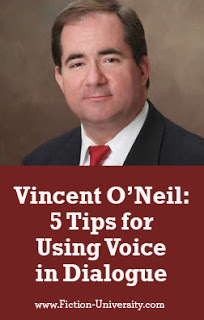 By Vincent H. O’Neil
By Vincent H. O’NeilPart of the How They Do It Series
JH: Voice is a tricky aspect of writing, from finding the author's voice to creating the voices of the characters. Please help me welcome Vincent O'Neil to the lecture hall today, to share his thought and tips on using voice in our dialogue.
Vincent H. O’Neil is the Malice Award-winning author of the Frank Cole mysteries and the theater-themed mystery Death Troupe . HarperCollins recently released the fifth and final novel in his military science fiction Sim War series, written as Henry V. O’Neil.
Website | Goodreads | Facebook |
Take it away Vincent...
Continue ReadingWritten by Janice Hardy. Fiction-University.com

Published on February 05, 2019 03:00
February 4, 2019
7 Reasons Why a First Draft Sucks
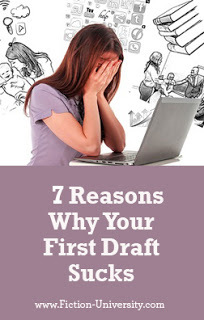 By Janice Hardy, @Janice_Hardy
By Janice Hardy, @Janice_Hardy First drafts are written first for a reason.
Getting to the end of a first draft is an accomplishment that ought to be celebrated, no matter what state that draft is in. It takes a lot of effort and determination to write an entire novel. It takes planning and brainstorming, and uses up a lot of creative juice to get all those ideas from our heads to the page.
It’s also not uncommon to stumble a bit and write a first draft that’s, shall we say, less than stellar. Maybe it even sucks.
If this is you, take heart—you’re not alone. Bad first drafts happen all the time, even to professional authors with dozens of books under their writing belts. Writing is a creative endeavor and you can’t force creativity, even if you can plow through it and keep writing when the muse is on vacation.
Continue ReadingWritten by Janice Hardy. Fiction-University.com

Published on February 04, 2019 04:22
February 3, 2019
Sunday Writing Tip: Get Rid of Unnecessary Adverbs
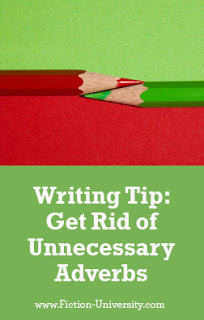 By Janice Hardy, @Janice_Hardy
By Janice Hardy, @Janice_Hardy Each week, I’ll offer a tip you can take and apply to your WIP to help improve it. They’ll be easy to do and shouldn’t take long, so they’ll be tips you can do without taking up your Sunday. Though I do reserve the right to offer a good tip now and then that will take longer—but only because it would apply to the entire manuscript.
This week, cut or revise any unnecessary adverbs.
Adverbs aren’t inherently bad, but they’re often a red flag for weak writing in the manuscript, and opportunities to make that writing stronger. They’re moments of emotion or action that could be fleshed out for greater impact or interest.
This task might take longer than the usual Sunday Tip, but search for ly [space], ly, ly. and possibly ly; in your manuscript. Examine any adverbs found (not all of them will be, such as family), and decide if it’s the best word for that sentence or if you can do better.
Continue ReadingWritten by Janice Hardy. Fiction-University.com

Published on February 03, 2019 03:00
February 2, 2019
Real Life Diagnostics: Is the Opening and Voice of this Literary Novel Compelling?
 Critique By Janice Hardy, @Janice_Hardy
Critique By Janice Hardy, @Janice_HardyReal Life Diagnostics is a weekly column that studies a snippet of a work in progress for specific issues. Readers are encouraged to send in work with questions, and we diagnose it on the site. It’s part critique, part example, and designed to help the submitter as well as anyone else having a similar problem.
If you're interested in submitting to Real Life Diagnostics, please check out these guidelines.
Submissions currently in the queue: Two
Please Note: As of today, RLD slots are booked through February 16.
This week’s questions:
I’m curious if this opening and the “voice” are compelling. I am also curious if the dialogue sounds realistic.
Market/Genre: Literary fiction
On to the diagnosis…
Continue ReadingWritten by Janice Hardy. Fiction-University.com

Published on February 02, 2019 06:04
February 1, 2019
The Daily Mindset Practice That Will Help You Achieve Your Writing Goals
 By Jennifer Blanchard
By Jennifer BlanchardPart of The Writer's Life Series
JH: Sometimes the things standing in the way of our writing dreams is our own doubts and fears. Jennifer Blanchard visits the lecture hall today to share tips on how to get our of our heads and back into our writing.
Jennifer Blanchard is an author, screenwriter, Developmental Book Editor, and the founder of The Feel-Good Life Center. Grab her FREE Story Secrets audio series here and start writing better stories.
Website | Goodreads | Facebook |
Take it away Jennifer...
Continue ReadingWritten by Janice Hardy. Fiction-University.com

Published on February 01, 2019 05:09
January 31, 2019
What to Do if Your Book Cover Sucks
 By Karen Amanda Hooper, @Karen_Hooper
By Karen Amanda Hooper, @Karen_HooperPart of The Indie Authors Series
JH: A terrible book cover can not only break an author's heart, but hurt the sales of that book. While traditionally published authors have little say (usually) in what their covers look like, indie authors have full control--but that doesn't mean they always get it right, either. Please help me welcome Karen Hooper to the lecture hall today, to share her experience with redesigning her covers and why.
An Amazon bestselling author, Karen Amanda Hooper writes magical romances for all ages. Her books range from the sea to the stars and beyond, including: The Kindrily series (YA paranormal), The Sea Monster Memoirs (YA fantasy), and Virtual Arcana (YA science-fiction).
Karen was born and bred in Baltimore, frolicked and froze in Colorado for a couple years, and is currently sunning and splashing around Florida with her beloved rescued bulldog. She's addicted to coffee, chocolate, and complicated happily-ever-afters.
Website | Facebook | Twitter | Instagram | Pinterest | Goodreads |
Take it away Karen...
Continue ReadingWritten by Janice Hardy. Fiction-University.com

Published on January 31, 2019 05:13
January 30, 2019
What Writers Need to Know About Hooks
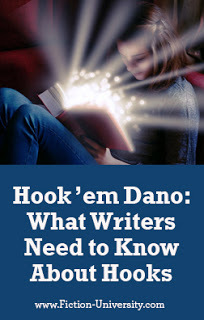 By Janice Hardy, @Janice_Hardy
By Janice Hardy, @Janice_HardyWriters get a lot of advice on the value of hooks in a novel, but “hook” can mean different things depending on its usage.
At every stage of a novel, you have different hooks and different needs. In the idea stage, the hook is the cool thing that makes you want to write it, and will make readers want to read it. In the drafting stage, you want to hook readers with the scenes themselves to keep them reading. In the polishing stage, you want sharp hook lines and clever twists.
Every one of these situations involve hooks, but each one uses them in a different way. Not understanding the various types of hooks can lead a writer astray and cause them to struggle to fix something in their novel that might not actually be broken.
Someone might tell you, “There’s no hook,” and refer to reasons why a reader would want to see a scene unfold. But another might mean there’s no unique concept behind the plot. A third might say there’s no cool twist or clever premise behind the story.
Continue ReadingWritten by Janice Hardy. Fiction-University.com

Published on January 30, 2019 05:26
January 29, 2019
New Market – New Game: Defining Short Fiction
 By Sarah Dahl, @sarahdahl13
By Sarah Dahl, @sarahdahl13Part of the Focus on Short Fiction Series
JH: A few months ago, I was chatting with Sarah Dahl about short fiction, discussing how little is “out there” about this side of the craft: writing shorter, and publishing it, and I asked her to do a series to focus on this growing market. In this (roughly) monthly series she'll discuss why writers might want to consider writing shorter – and how they can make the most of it.
Sarah Dahl lives on the edge of the rural German Eifel and writes historical fiction (novels and short stories) primarily set in the Viking age. She was an editor in several German publishing houses and managed a translation agency. The magic of writing re-entered her life at UCD Dublin, where she sat in J.R.R. Tolkien’s office every day, while working on the ‘Dictionary of Hiberno-English’. Tolkien’s spirit must have done something to her creative muscles – it sure wasn’t the bland view from his office. She became a full-time writer soon after and still works as an editor, translates, and coaches new authors. She is interested in everyday life in bygone centuries and the human stories that may have occurred behind the hard, historical facts. Sarah just released her collection Tales of Freya , seven sensual short stories set in the Viking age.
Website | Goodreads | Facebook | Twitter | Pinterest | Newsletter
Take it away Sarah...
Continue ReadingWritten by Janice Hardy. Fiction-University.com

Published on January 29, 2019 05:24
January 28, 2019
All Is Lost: Four Kinds of Death in Fiction
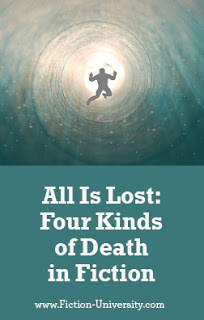 By Janice Hardy, @Janice_Hardy
By Janice Hardy, @Janice_Hardy Death comes in many forms, especially when you’re writing a novel.
With the popularity of Blake Snyder’s Save the Cat beat sheet, the “Whiff of Death” moment has many writers asking, “Do I need to kill someone every book?” Of course not. You also shouldn’t do it just because a popular story structure format says you should. But for stories that will benefit from a “death” for emotional or storytelling impact, the All Is Lost moment is a great opportunity to grab a reader by the feels.
While the death part of “whiff of death” suggests we actually kill someone, it’s not recommending an actual death every time. Death refers to a loss, usually profound, for the protagonist. That can mean a character bites the dust, but it can also mean the loss of hope, or the loss something once held dear.
Continue ReadingWritten by Janice Hardy. Fiction-University.com

Published on January 28, 2019 03:00
January 27, 2019
Sunday Writing Tip: Make Sure Your Scene Beginnings Hook Your Readers
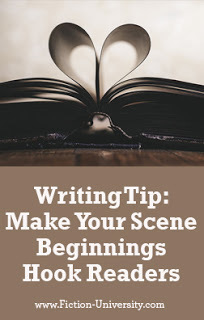 By Janice Hardy, @Janice_Hardy
By Janice Hardy, @Janice_Hardy Each week, I’ll offer a tip you can take and apply to your WIP to help improve it. They’ll be easy to do and shouldn’t take long, so they’ll be tips you can do without taking up your Sunday. Though I do reserve the right to offer a good tip now and then that will take longer—but only because it would apply to the entire manuscript.
This week, check how you open each scene and/or chapter and make sure you’re giving readers a reason to turn the page.
So last week we looked at our scene endings. This week, let’s look at how we’re beginning each scene and chapter.
The beginning of a scene or chapter is where we show readers why they want to read this scene. There needs to be something in it for them, otherwise they might set the book down and go watch TV. You want to ask the right story questions to pique their interest and make them want to learn the answers to them. You want to tempt them with the potential for something bad to happen. You even want to dangle the possibility of good things happening that they’ve been hoping for all along.
Continue ReadingWritten by Janice Hardy. Fiction-University.com

Published on January 27, 2019 03:00



